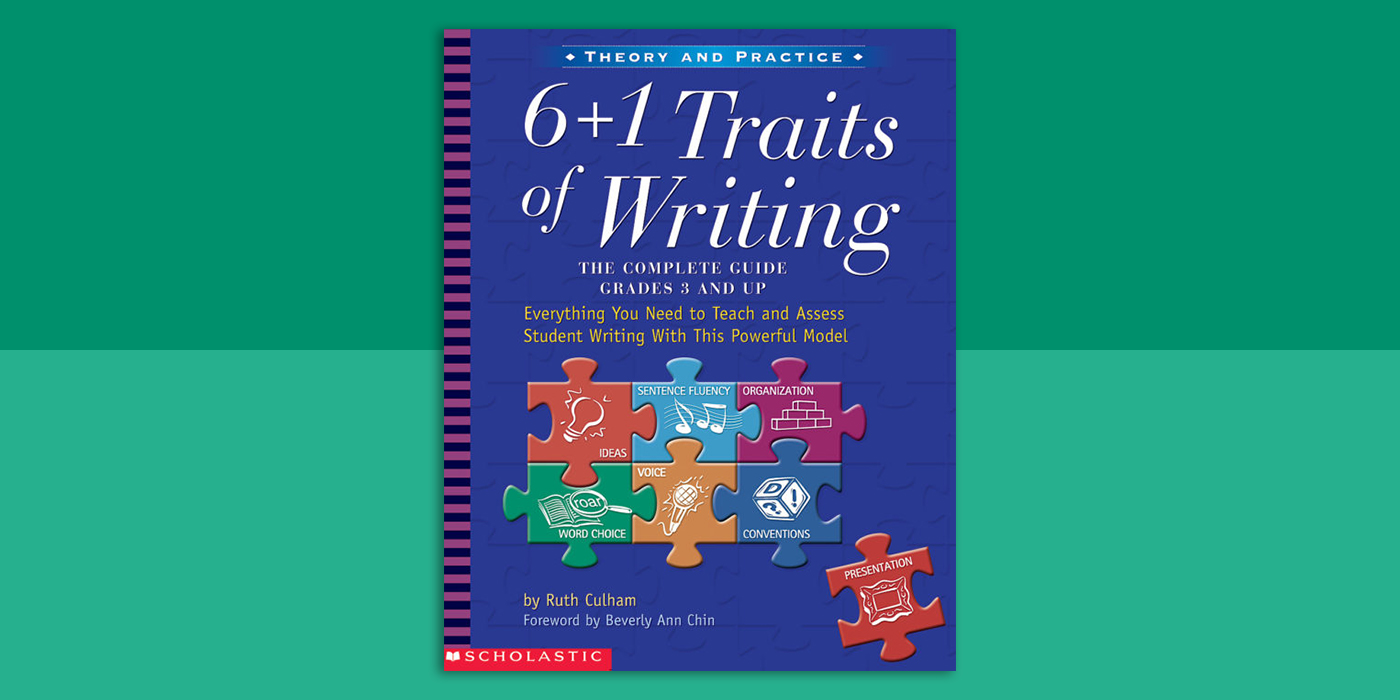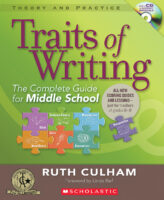6+1 Traits of Writing: The Complete Guide: Grades 3 and Up
Everything You Need to Teach and Assess Student Writing With This Powerful Model
By Ruth Culham
How the 6+1 TRAIT Model Improves Students' Writing
In 6+1 Traits of Writing: The Complete Guide: Grades 3 and Up, I outline how the 6+1 TRAIT model is more than an approach to teaching and assessing writing. It’s a vocabulary that teachers use to describe their vision of what good writing looks like—any kind of writing. Whether it’s a story about a quirky music teacher, an essay on the effects of global warming, or a persuasive piece on why Harry Potter books should be in every school library, certain characteristics—or traits—make the writing work: ideas, organization, voice, word choice, sentence fluency, conventions, and presentation. Using the language of the 6+1 TRAIT model in our assessments gives us a shared vocabulary for speaking about and working with texts that students create.
The 6+1 TRAIT model is also form of analytic assessment, a method of looking at the main characteristics of writing and assessing them independent from one another. From its early conception to its present form, this model has provided classroom teachers with a powerful tool for communication about writing performance, one that far exceeds the limited information a single grade or score provides. By clearly defining the qualities of good writing, and helping teachers use that knowledge in the classroom, the model ensures that students receive useful feedback to improve their writing as it develops.
Student writing improves when the traits are used in a systematic way in the classroom and throughout the school. We must build curriculum that maintains a shared view of what “good” writing looks like that remains constant throughout the school years, K to 12. If expectations for students’ work keep building one year to the next, based on the same core criteria, we save valuable time reviewing and revising curriculum, which allows infinite opportunities for growth.
All writers need specific and direct feedback on their work, regardless of their stage of development. It’s important to explain to writers, or help them discover for themselves, the reasons a piece is or isn’t working and what to do about it. For those who have done a fine job, we want to realize that this is more than a happy accident, and that by recognizing the traits of success in their work, they can do it again and again. For those who are struggling, we want them to understand that writing is hard, but if they know what they are shooting for and have consistent and honest feedback, their work will improve with every attempt—and that’s no accident, either.
To learn more about 6+1 Traits of Writing: The Complete Guide: Grades 3 and Up, you can purchase the book here.
About the author:
Ruth Culham, Ed.D., has published more than 40 best-selling professional books and resources with Scholastic and the International Literacy Association on the traits of writing and teaching writing using reading as a springboard to success. Her steadfast belief that every student is a writer is the hallmark of her work. As the author of Traits Writing: The Complete Writing Program for Grades K–8 (2012), she has launched a writing revolution. Traits Writing is the culmination of 40 years of educational experience, research, practice, and passion.
How to Help Students Incorporate Their Voice Into Writing
Voice emerges when the writer approaches the topic at an emotional level. One sure way to help students do that is through music. Whether it’s an old classic that they’ve heard over and over or something contemporary, music reaches deep inside all of us and helps us to feel. This activity from 6+1 Traits of Writing: The Complete Guide Grades 3 and Up will help students recognize voice and inspire them to incorporate it into their own writing:
What To Do:
- Find 3 to 5 different versions of a popular song that has been recorded by different artists over the years. (Beatles’ songs are a good place to start!)
- Before you play the original version of the song, tell students all you know about the song: when it was recorded, by whom, and so forth. Then ask them to close their eyes and just listen to the recording.
- Play the piece again, only this time ask students to record any feelings, emotions, connections, and images that may occur to them. Ask them to keep a running list of the words that describe the voice of the piece: “thoughtful,” “moody,” and “caring,” for example.
- Have students put their first collection of words aside, play another version of the same song, and ask them to list their thoughts again. It’s important for students to hear each piece a couple of times to truly appreciate the differences between the songs.
- Now play the other versions—as many as you can find. As students listen to version after version, their papers should fill with words describing what makes each one unique.
- As a class, record on the blackboard or on chart paper the different voices students heard for each rendition.
- Discuss the various responses and the role of voice in each recording.
- Challenge students to summarize each rendition in a sentence that captures the essence of its voice.
Follow up with more discussion by asking students how listening to music is like reading somebody’s writing. Let them talk or write out their ideas and be sure to allow plenty of time to share. You’ll be amazed at the depth of their understanding. And once students see voice as a powerful tool to make their writing stronger, they will look for ways to add it on their own.
Find more activities to teach students the 6+1 TRAIT model of writing with 6+1 Traits of Writing: The Complete Guide Grades 3 and Up. You can purchase the book here.



